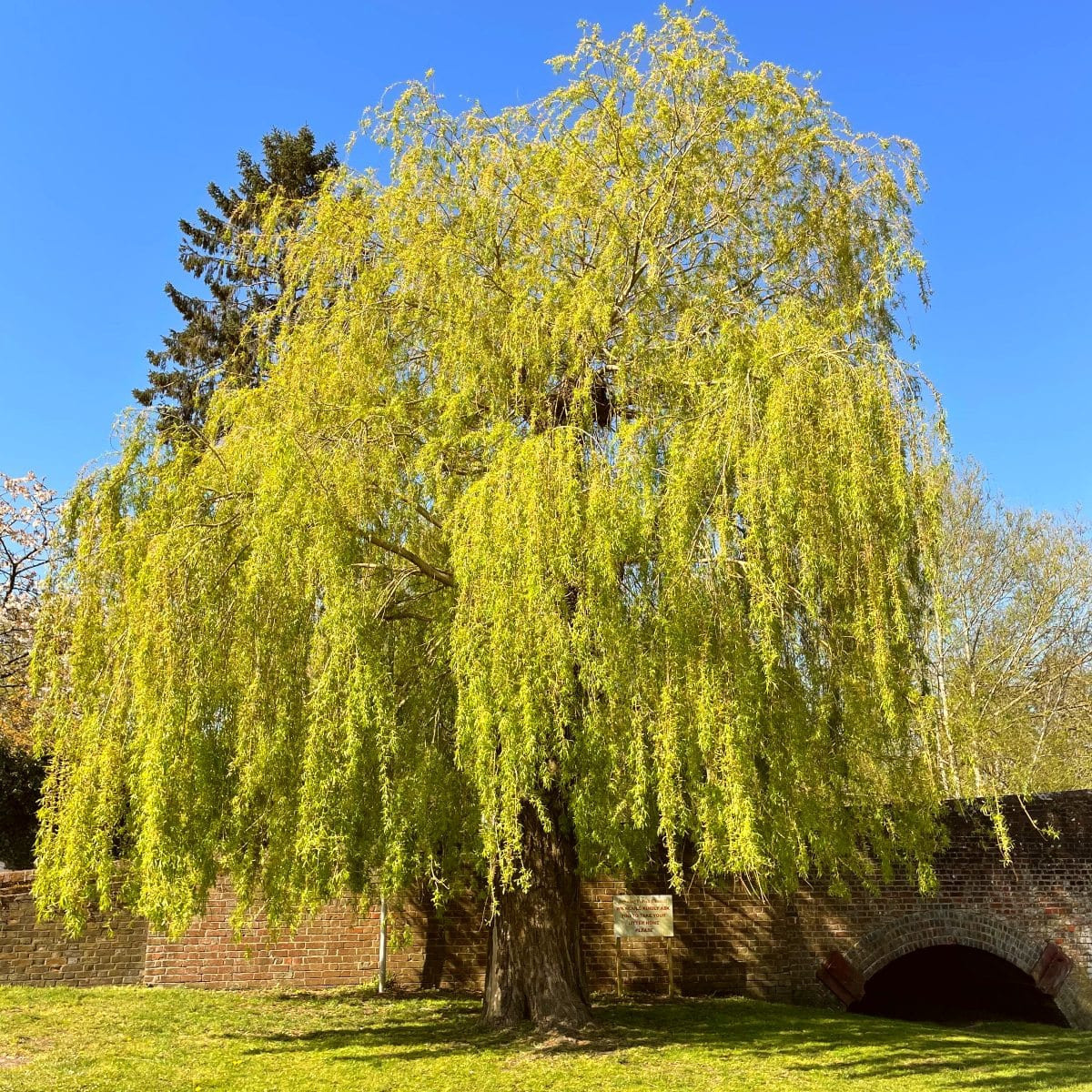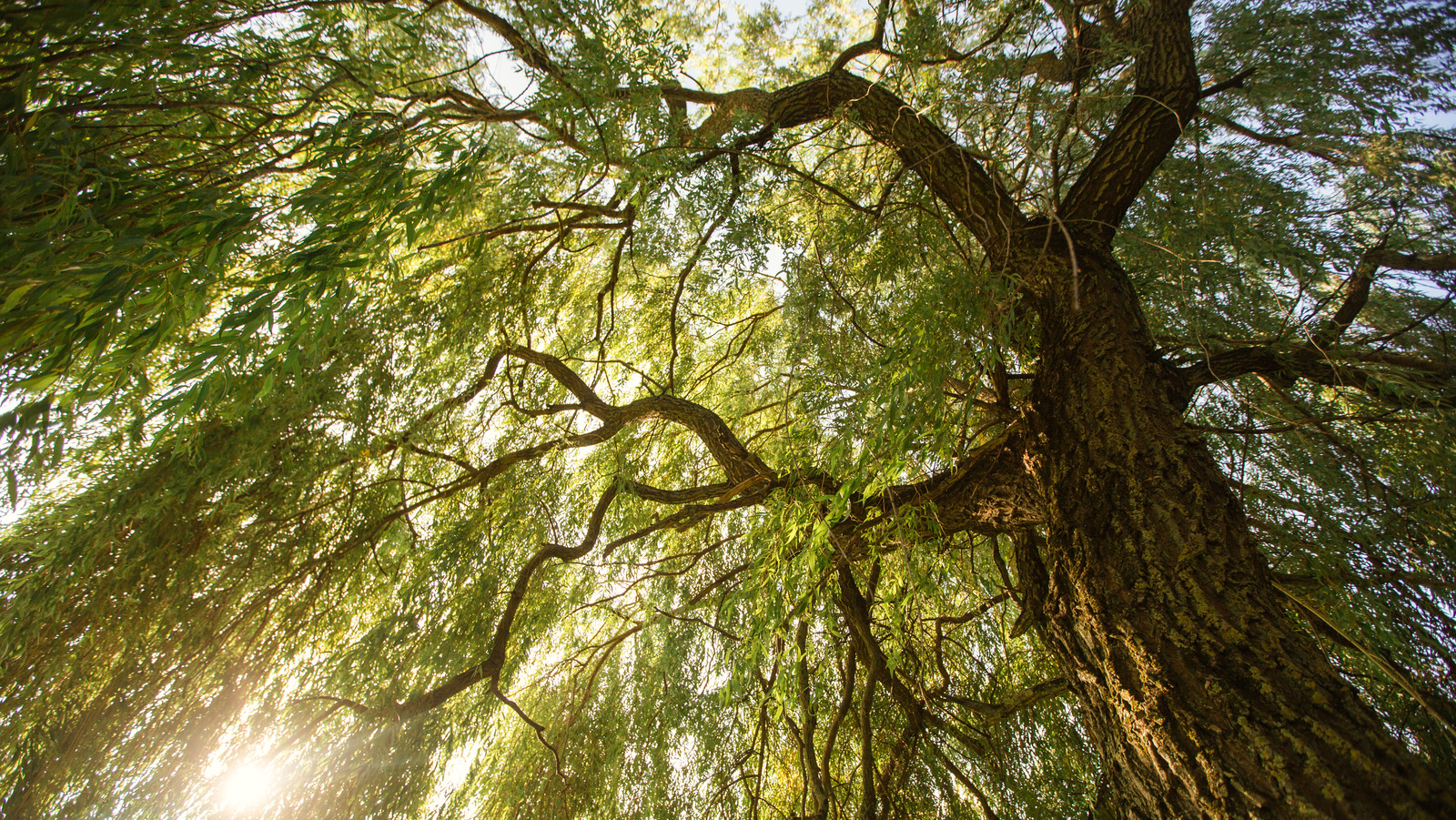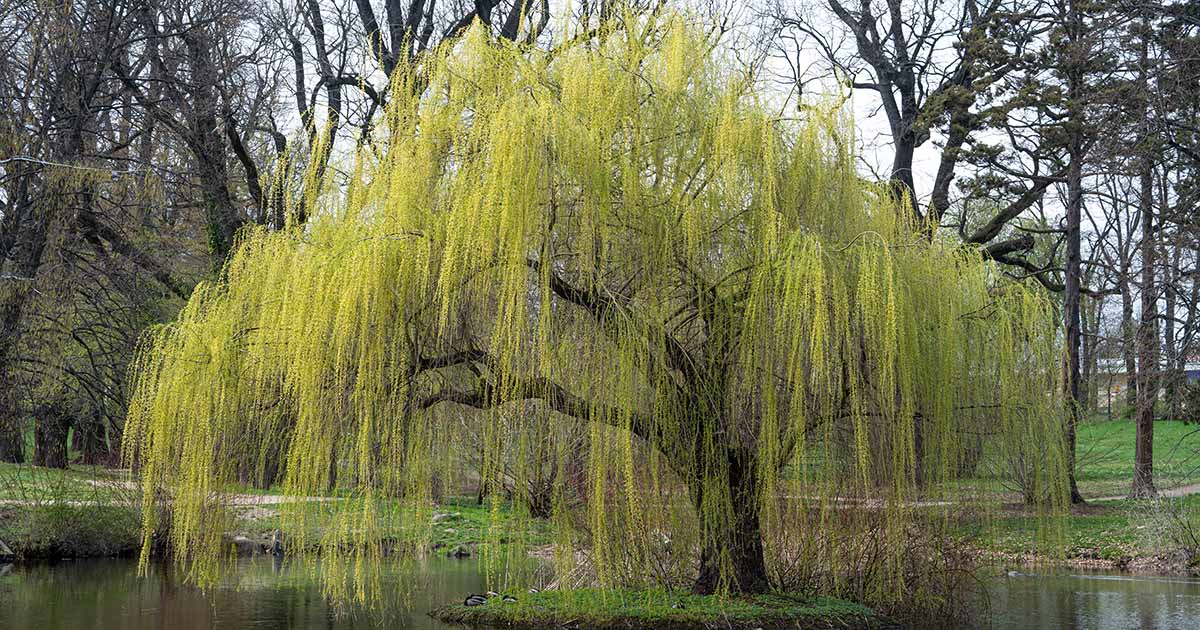Choosing the Perfect Location for Your Weeping Willow
When it comes to planting a weeping willow tree, selecting the right location is crucial for its growth and development. Weeping willows are known for their majestic, sweeping branches and stunning foliage, but they require specific conditions to thrive. To ensure your tree grows healthy and strong, consider the following factors when choosing a location.
Sunlight is essential for weeping willows, so choose a location that receives full sun to partial shade. Weeping willows can tolerate a range of soil types, but they prefer well-draining soil with a pH between 6.0 and 8.0. If your soil is heavy clay or prone to waterlogging, consider raising the bed or adding organic matter to improve drainage.
Space constraints are also important to consider when planting a weeping willow. These trees can grow up to 30 feet tall and 40 feet wide, so ensure you have enough space for the tree to mature. Avoid planting near power lines, buildings, or other structures that may interfere with the tree’s growth.
To assess your yard’s conditions, take note of the sunlight patterns, soil type, and space constraints. Walk around your yard and observe the areas that receive the most sunlight and have the best drainage. Consider the mature size of the tree and ensure you have enough space for it to grow.
By choosing the perfect location for your weeping willow tree, you’ll set it up for success and enjoy its beauty for years to come. Whether you’re looking to create a stunning focal point or provide shade for your outdoor living space, a weeping willow tree is a great choice. Now that you’ve selected the perfect location, it’s time to prepare the soil for optimal growth.
Preparing the Soil for Optimal Growth
Once you’ve selected the perfect location for your weeping willow tree, it’s essential to prepare the soil for optimal growth. Weeping willows prefer well-draining soil with a pH between 6.0 and 8.0. To determine your soil’s pH, you can purchase a soil testing kit or send a sample to a laboratory for analysis.
If your soil test reveals that your soil is too acidic or alkaline, you may need to amend it. Adding organic matter such as compost or well-rotted manure can help adjust the pH and improve soil structure. Mix 2-4 inches of organic matter into the top 6-8 inches of soil to create a fertile and well-draining growing medium.
In addition to adjusting the pH, it’s essential to improve soil fertility. Weeping willows are heavy feeders and require a balanced diet of nutrients to thrive. You can add a slow-release fertilizer to the soil according to the manufacturer’s instructions. This will provide your tree with a steady supply of nutrients throughout the growing season.
When preparing the soil, it’s also essential to remove any debris or weeds that may compete with your tree for water and nutrients. Clear the area of any rocks, twigs, or weeds, and till the soil to a depth of 8-10 inches. This will help loosen the soil and create a smooth, even surface for planting.
By preparing the soil for optimal growth, you’ll give your weeping willow tree the best possible start in life. A well-prepared soil will help your tree establish a strong root system, promote healthy growth, and reduce the risk of disease and pests. With the soil prepared, you’re now ready to acquire a healthy weeping willow tree and begin the planting process.
Acquiring a Healthy Weeping Willow Tree
When acquiring a weeping willow tree, it’s essential to select a healthy tree with a well-developed root system and a straight trunk. A healthy tree will have a better chance of thriving in its new environment and will require less maintenance in the long run.
When selecting a weeping willow tree from a nursery or garden center, look for trees with a sturdy trunk and a well-developed root system. Avoid trees with signs of disease or pests, such as yellowing leaves, black spots, or white powdery patches. Also, avoid trees with weak or spindly branches, as these may not be able to support the weight of the tree’s foliage.
A healthy weeping willow tree will typically have a single leader or main trunk, with a well-developed root system that is visible above the soil surface. The tree should also have a balanced canopy, with branches that are evenly spaced and well-distributed around the trunk.
When purchasing a weeping willow tree, make sure to inspect the tree’s roots and trunk carefully. Look for any signs of damage or disease, and avoid trees with roots that are circling or growing out of the container. A healthy tree will have a robust root system that is well-established in the soil.
By selecting a healthy weeping willow tree, you’ll be able to enjoy its beauty and benefits for years to come. With proper care and maintenance, a weeping willow tree can thrive in a variety of environments and provide shade, shelter, and habitat for wildlife.
Now that you’ve acquired a healthy weeping willow tree, it’s time to plant it in its new home. In the next section, we’ll discuss the step-by-step process of planting a weeping willow tree, including digging the hole, removing the tree from its container, and backfilling with soil.
Planting Your Weeping Willow Tree: A Step-by-Step Process
Now that you’ve acquired a healthy weeping willow tree and prepared the soil, it’s time to plant it in its new home. Planting a weeping willow tree requires careful attention to detail to ensure the tree establishes a strong root system and thrives in its new environment.
Step 1: Dig the Hole – Dig a hole that is twice as wide and just as deep as the tree’s root ball. If your soil is poorly draining, consider raising the bed by 2-3 inches to improve drainage.
Step 2: Remove the Tree from Its Container – Gently remove the tree from its container, taking care not to damage the roots. If the roots are circling or growing out of the container, use a sharp knife or pruning saw to gently tease them apart.
Step 3: Place the Tree in the Hole – Position the tree in the hole, making sure the root flare (where the trunk flares out at the base of the tree) is level with the soil surface. If necessary, add a layer of soil or organic matter to the bottom of the hole to achieve the correct planting depth.
Step 4: Backfill with Soil – Fill the hole with soil, tamping it down gently as you go to prevent air pockets from forming. Make sure to leave enough space between the soil surface and the top of the root ball for watering and mulching.
Step 5: Water and Mulch – Water the tree thoroughly after planting, and apply a layer of organic mulch to retain moisture and suppress weeds. Keep the mulch layer thin (2-3 inches) and avoid piling it against the trunk, as this can cause damage to the tree.
By following these steps, you’ll be able to plant your weeping willow tree with confidence and give it the best possible start in life. Remember to water and mulch your tree regularly, especially during its first year, to ensure it establishes a strong root system and thrives in its new environment.
Watering and Mulching Your Newly Planted Weeping Willow
After planting your weeping willow tree, it’s essential to provide it with the right amount of water and mulch to ensure it establishes a strong root system and thrives in its new environment. Proper watering and mulching techniques can make a significant difference in the health and growth of your tree.
Watering Your Weeping Willow Tree – Water your weeping willow tree regularly, especially during its first year. Aim to provide about 1 inch of water per week, either from rainfall or irrigation. Avoid overwatering, as this can cause the roots to rot and the tree to become susceptible to disease.
Mulching Your Weeping Willow Tree – Mulching is an excellent way to retain moisture, suppress weeds, and regulate soil temperature. Apply a 2-3 inch layer of organic mulch, such as wood chips or bark, around the base of the tree. Keep the mulch layer thin and avoid piling it against the trunk, as this can cause damage to the tree.
Benefits of Mulching – Mulching can provide several benefits for your weeping willow tree, including retaining moisture, suppressing weeds, and regulating soil temperature. Mulch can also help to reduce soil compaction and prevent erosion.
How to Mulch – To mulch your weeping willow tree, start by clearing the area around the base of the tree of any debris or weeds. Then, apply a 2-3 inch layer of organic mulch, such as wood chips or bark, around the base of the tree. Keep the mulch layer thin and avoid piling it against the trunk, as this can cause damage to the tree.
By following these watering and mulching tips, you can help your weeping willow tree establish a strong root system and thrive in its new environment. Remember to water your tree regularly, especially during its first year, and apply a layer of organic mulch to retain moisture and suppress weeds.
Pruning and Training Your Weeping Willow Tree
Pruning and training your weeping willow tree is essential to maintain its shape and promote healthy growth. Pruning involves removing any dead or damaged branches, while training involves guiding the tree’s branches to create a beautiful, weeping canopy.
Why Prune Your Weeping Willow Tree? – Pruning your weeping willow tree helps to remove any dead or damaged branches, which can help prevent disease and pests from spreading. It also helps to maintain the tree’s shape and promote healthy growth.
How to Prune Your Weeping Willow Tree – To prune your weeping willow tree, start by removing any dead or damaged branches. Use a pair of sharp, clean pruning shears to make clean cuts just above a growth node. Make sure to disinfect your pruning shears between cuts to prevent the spread of disease.
Training Your Weeping Willow Tree – Training your weeping willow tree involves guiding its branches to create a beautiful, weeping canopy. To train your tree, start by selecting a few strong, healthy branches to serve as the tree’s framework. Use twine or wire to gently tie these branches to a stake or trellis, guiding them into the desired shape.
Benefits of Pruning and Training – Pruning and training your weeping willow tree can help to promote healthy growth, maintain the tree’s shape, and create a beautiful, weeping canopy. Regular pruning and training can also help to prevent disease and pests from spreading, and can help to reduce the risk of branch failure.
By following these pruning and training tips, you can help your weeping willow tree maintain its shape and promote healthy growth. Remember to prune your tree regularly, removing any dead or damaged branches, and train its branches to create a beautiful, weeping canopy.
Common Challenges and Solutions for Weeping Willow Tree Care
While weeping willow trees are generally easy to care for, there are some common challenges that may arise. In this section, we’ll discuss some of the most common challenges and provide solutions and tips on how to overcome them.
Pests – Weeping willow trees can be susceptible to pests such as aphids, scales, and spider mites. To control pests, use insecticidal soap or neem oil, and make sure to follow the instructions on the label.
Diseases – Weeping willow trees can be susceptible to diseases such as powdery mildew, leaf spot, and root rot. To control diseases, use fungicides, and make sure to follow the instructions on the label.
Environmental Stressors – Weeping willow trees can be susceptible to environmental stressors such as drought, extreme temperatures, and wind. To mitigate environmental stressors, make sure to water your tree regularly, provide shade during extreme temperatures, and use windbreaks to protect your tree from strong winds.
How to Identify Common Challenges – To identify common challenges, regularly inspect your tree for signs of pests, diseases, and environmental stressors. Look for signs such as yellowing leaves, black spots, or white powdery patches, and take action immediately if you notice any of these signs.
Prevention is Key – Prevention is key when it comes to common challenges. Regularly inspect your tree, use insecticidal soap or neem oil to control pests, and use fungicides to control diseases. Also, make sure to water your tree regularly, provide shade during extreme temperatures, and use windbreaks to protect your tree from strong winds.
By following these tips and solutions, you can help your weeping willow tree overcome common challenges and thrive in its environment. Remember to regularly inspect your tree, use insecticidal soap or neem oil to control pests, and use fungicides to control diseases.
Enjoying the Beauty and Benefits of Your Mature Weeping Willow Tree
After years of care and attention, your weeping willow tree has matured into a stunning and majestic specimen. Its long, sweeping branches and delicate leaves create a beautiful canopy that provides shade and shelter from the elements.
Benefits of a Mature Weeping Willow Tree – A mature weeping willow tree provides numerous benefits, including shade provision, wildlife habitat creation, and soil erosion prevention. Its extensive root system also helps to stabilize the soil and prevent landslides.
Appreciating Your Tree’s Unique Characteristics – Every weeping willow tree is unique, with its own distinct characteristics and features. Take the time to appreciate your tree’s unique shape, size, and color, and enjoy the beauty it brings to your landscape.
Creating a Wildlife Habitat – A mature weeping willow tree provides a habitat for a variety of wildlife, including birds, insects, and small mammals. Consider adding a birdhouse or bird feeder to your tree to attract more wildlife and create a thriving ecosystem.
Enjoying the Shade – A mature weeping willow tree provides a cool and shaded area that’s perfect for relaxation and recreation. Consider adding a patio or seating area under your tree to enjoy the shade and beauty it provides.
By following these tips and appreciating the beauty and benefits of your mature weeping willow tree, you can enjoy the fruits of your labor and create a stunning and majestic landscape that will be the envy of your neighbors.








